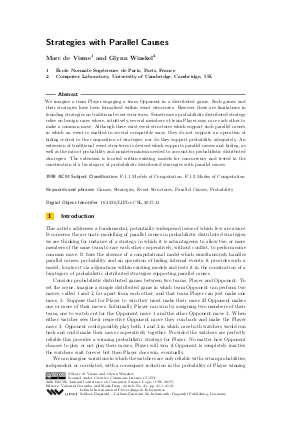Strategies with Parallel Causes
Authors Marc de Visme, Glynn Winskel
-
Part of:
Volume:
26th EACSL Annual Conference on Computer Science Logic (CSL 2017)
Part of: Series: Leibniz International Proceedings in Informatics (LIPIcs)
Part of: Conference: Computer Science Logic (CSL) - License:
 Creative Commons Attribution 3.0 Unported license
Creative Commons Attribution 3.0 Unported license
- Publication Date: 2017-08-16
File

PDF
LIPIcs.CSL.2017.41.pdf
- Filesize: 0.55 MB
- 21 pages
Document Identifiers
Subject Classification
Keywords
- Games
- Strategies
- Event Structures
- Parallel Causes
- Probability
Metrics
- Access Statistics
-
Total Accesses (updated on a weekly basis)
0PDF Downloads0Metadata Views
Abstract
We imagine a team Player engaging a team Opponent in a distributed game. Such games and their strategies have been formalised within event structures. However there are limitations in founding strategies on traditional event structures. Sometimes a probabilistic distributed strategy relies on benign races where, intuitively, several members of team Player may race each other to make a common move. Although there exist event structures which support such parallel causes, in which an event is enabled in several compatible ways, they do not support an operation of hiding central to the composition of strategies; nor do they support probability adequately. An extension of traditional event structures is devised which supports parallel causes and hiding, as well as the mix of probability and nondeterminism needed to account for probabilistic distributed strategies. The extension is located within existing models for concurrency and tested in the construction of a bicategory of probabilistic distributed strategies with parallel causes.
Cite As Get BibTex
Marc de Visme and Glynn Winskel. Strategies with Parallel Causes. In 26th EACSL Annual Conference on Computer Science Logic (CSL 2017). Leibniz International Proceedings in Informatics (LIPIcs), Volume 82, pp. 41:1-41:21, Schloss Dagstuhl – Leibniz-Zentrum für Informatik (2017)
https://doi.org/10.4230/LIPIcs.CSL.2017.41
BibTex
@InProceedings{devisme_et_al:LIPIcs.CSL.2017.41,
author = {de Visme, Marc and Winskel, Glynn},
title = {{Strategies with Parallel Causes}},
booktitle = {26th EACSL Annual Conference on Computer Science Logic (CSL 2017)},
pages = {41:1--41:21},
series = {Leibniz International Proceedings in Informatics (LIPIcs)},
ISBN = {978-3-95977-045-3},
ISSN = {1868-8969},
year = {2017},
volume = {82},
editor = {Goranko, Valentin and Dam, Mads},
publisher = {Schloss Dagstuhl -- Leibniz-Zentrum f{\"u}r Informatik},
address = {Dagstuhl, Germany},
URL = {https://drops.dagstuhl.de/entities/document/10.4230/LIPIcs.CSL.2017.41},
URN = {urn:nbn:de:0030-drops-76800},
doi = {10.4230/LIPIcs.CSL.2017.41},
annote = {Keywords: Games, Strategies, Event Structures, Parallel Causes, Probability}
}
Author Details
References
-
Ioana Cristescu. Operational and denotational semantics for the reversible pi-calculus. PhD thesis, PPS, Université Paris Diderot, 2015.

-
G. M. Kelly. Basic concepts of enriched category theory. LNM 64. CUP, 1982.

-
Y. Kinoshita and J. Power. Category theoretic structure of setoids. Theor. Comput. Sci., 546, 2014.

-
John McCarthy. A basis for a mathematical theory of computation. In P. Brafford and D. Hirschberg, editors, Computer Programming and Formal Systems. North-Holland, 1963.

-
Mogens Nielsen, Gordon Plotkin, and Glynn Winskel. Petri nets, event structures and domains. TCS, 13:85-108, 1981.

-
Judea Pearl. Causality. CUP, 2013.

-
John Power. 2-categories. BRICS Notes Series NS-98-7, 1998.

-
Silvain Rideau and Glynn Winskel. Concurrent strategies. In LICS, 2011.

-
Glynn Winskel. Events in computation. PhD thesis, University of Edinburgh, 1980.

-
Glynn Winskel. Event structures. In Advances in Petri Nets, LNCS 255, 1986.

-
Glynn Winskel. Distributed probabilistic and quantum strategies. ENTCS 298, 2013.

- Glynn Winskel. Event structures, stable families and concurrent games, 2016. URL: https://www.cl.cam.ac.uk/~gw104/ecsym-notes.pdf.
-
Glynn Winskel and Mogens Nielsen. Handbook of Logic in Computer Science 4, chapter Models for Concurrency, pages 1-148. OUP, 1995.

